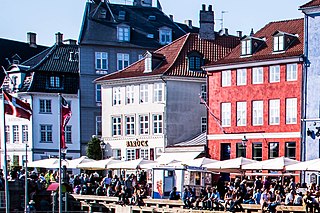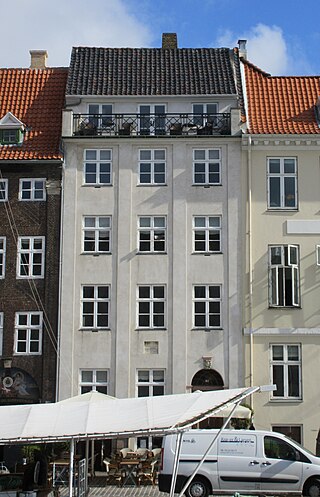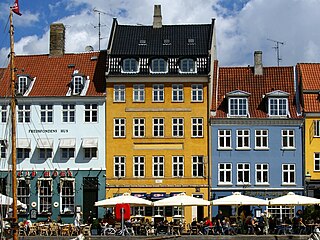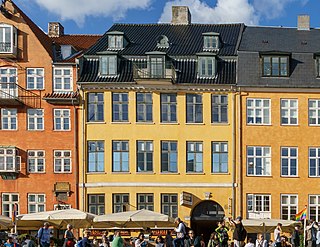
Nyhavn 1 is an 18th-century property at the acute corner of Nyhavn with Store Strandstræde in central Copenhagen, Denmark. It was listed in the Danish registry of protected buildings and places in 1987. Notable former residents include actor and singer Peter Schram (1819–1895).

Nyhavn 51 is an 18th-century canal house overlooking the Nyhavn canal in central Copenhagen, Denmark.Above the door is a painted stone relief depicting a lamb. The property was formerly known as Lammet and the sign was used for identification in a time when house numbers had still not been introduced. The letters are the initials of the builder Henrich Lambertsen Engel and his wife Karen Nielsdatter Holm. The building was listed in the Danish registry of protected buildings and places in 1918. It was subject to Schalburgtage during World War II but restored. Notable former residents include the portrait painter Hans Jørgen Hammer, the marine artist Carl Frederik Sørensen and Swedish actress Eva Eklund.

The Verrayon House is a Rococo, bourgeoisie townhouse located at Lille Strandstræde 6 in central Copenhagen, Denmark. It was listed by the Danish Heritage Agency in the Danish national registry of protected buildings in 1943.

Nyhavn 67 is a listed property overlooking the Nyhavn Canal in central Copenhagen, Denmark. The writer Hans Christian Andersen lived in the building as a lodger with only short interruptions from 1848 to 1865.

Nyhavn 13 is a historic townhouse overlooking the Nyhavn Canal in central Copenhagen, Denmark. With roots dating back to the late 17th century, it owes its current appearance to a heightening of the building with two floors in 1842. Notable former residents include the businessman Abraham Marcus Hirschsprung and the painter and educator Wilhelm Kyhn. The building was listed in the Danish registry of protected buildings and places in 1945.

Nyhavn 15 is a historic townhouse overlooking the Nyhavn Canal in central Copenhagen, Denmark. The building was listed in the Danish registry of protected buildings and places in 1945.

Nyhavn 23 is a Neoclassical property overlooking the Nyhavn Canal in central Copenhagen, Denmark. It was listed in the Danish registry of protected buildings and places in 1918. A plaque on the facade commemorates the composer Friedrich Kuhlau, who resided there in 1832.

Nyhavn 41 is a listed property overlooking the Nyhavn canal in central Copenhagen, Denmark. For most of the 19th century, the property was owned by a family of sailmakers. The manufacturing of flags and compasses was also part of their trade. The building was listed in the Danish registry of protected buildings and places in 1918.

Badstuestræde 18 is a Neoclassical property in Badstuestræde in the Old Town of Copenhagen, Denmark, constructed for brewer Peter Møller as part of the rebuilding of the city following the Copenhagen Fire of 1795. It was listed in the Danish registry of protected buildings and places in 1918. Notable former residents include the philologist Jacob Baden, actor Peter Jørgen Frydendahl, ballet master Carl Dahlén, actress and opera singer Johanna Elisabeth Dahlén and later ballet master of the Royal Swedish Ballet, Sigurd Harald Lund.

Nyhavn 43 is a historic townhouse overlooking the Nyhavn Canal in central Copenhagen, Denmark. The building was listed on the Danish registry of protected buildings and places in 1945. It was refurbished in 1987.

Nyhavn 27 is an 18th-century property overlooking the Nyhavn Canal in central Copenhagen, Denmark. The building was listed in the Danish registry of protected buildings and places in 1945. In the 18th century, it was for a while owned by the timber merchant Andreas Bodenhoff. The building was later operated as a hotel under the name Stadt Flensburg.

Ny Vestergade 9 is an 18th-century building located across the street from the main entrance to the National Museum in central Copenhagen, Denmark. Former owners include court painter Hendrick Krock, printmaker Hans Qvist, Royal Armourer Christian Kyhl and wholesaler Jacob Stilling-Andersen. The building was listed in the Danish Registry of Protected Buildings and Places in 1932.

Nybrogade 26 is a property overlooking Slotsholmen Canal in central Copenhagen, Denmark. It consists of a seven-bays-wide, four-storey residential building towards the canal and a former brewery building from the beginning of the 19th century at Magstræde 13 on the other side of the block. The entire complex was listed in the Danish registry of protected buildings and places in 1918. Notable former residents include the army officer and engineer Ernst Peymann (1737-1823). theologian Peter Rørdam (1806-1883) and mathematician and politician Adolph Steen (1816-1886).

Nyhavn 45 is an 18th-century property overlooking the Nyhavn Canal in central Copenhagen, Denmark. It was listed in the Danish registry of protected buildings and places in 1945.

Nyhavn 61 is an 18th-century residential building overlooking the Nyhavn canal in central Copenhagen, Denmark. The building was listed in the Danish registry of protected buildings and places in 1945. The scope of the heritage listing was expanded in 1984. Nyhavn 61 and Nyhavn 59 have now been merged into a single property and are physically integrated on the third floor. The two buildings share a central courtyard.

Nyhavn 5 is an 18th-century property overlooking the Nyhavn canal in central Copenhagen, Denmark. It was listed in the Danish registry of protected buildings and places in 1945. Notable former residents include the actor Adam Gottlob Gielstrup, opera singer Peter Schram and businessman Cornelius Peter August Koch.

The Gerling House is a late 17th-century building complex situated at Strandgade 38 in the Christianshavn district of central Copenhagen, Denmark. It consists of a three-storey, four-bays-wide front wing towards the street and a 13-bays-long two-storey side wing on its rear. The master cooper Peter Richter established a cooper's workshop in the building in the 1830s and the property was after his death owned by his widow until 1880. The building was listed in the Danish registry of protected buildings and places in 1918. Notable former residents include the naval officer and painter Sophus Schack.

Nyhavn 17 is a late 17th-century building situated at the corner of Nyhavn and Lille Strandstræde in central Copenhagen, Denmark. It was listed on the Danish registry of protected buildings and places in 1951. Tattoo-Ole, a tattoo shop located in the basement, claims to be the oldest still functioning tattoo shop in the world.

Nyhavn 6 is a Neoclassical building situated on the quiet southern side of the Nyhavn canal in central Copenhagen, Denmark. It was listed in the Danish registry of protected buildings and places in 1950. Composer Carl Nielsen and sculptor Anne Marie Carl-Nielsen had their first home together in the garret in the 1890s.

Kvæsthusgade 1/Nyhavn 69 is a three-storey building situated at the corner of Nyhavn and Kvæsthusgade. A memorial featuring a bust of a diver wearing a diving helmet commemorates that Em. Z. Svitzer's Bjernings-Enterprise, a salvage company founded by Emil Zeuthen Svitzer back in 1833, was once headquartered in the building. Notable former residents include the actress Magda von Dolcke.























